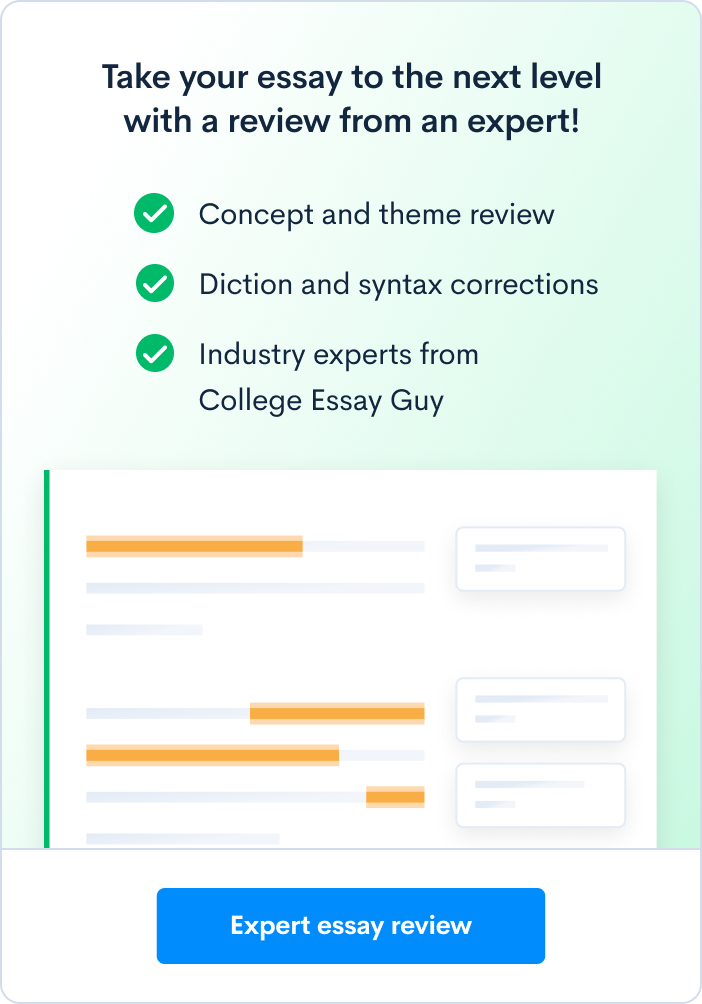How to Use Rhetorical Devices in Your College Essay
Writing the personal statement is one of the most important, yet difficult aspects of the college application process. The elusive perfect personal statement is deeply moving, expertly written, rich with details of accomplishments or inspiring life stories, and fits neatly into the word limit. These constraints can leave many struggling to fit what they want to say in so few words. But what many fail to realize when writing personal statements is that admissions officers are evaluating more than just the story you have to tell. They’re also examining your writing style and ability to convey the abstract qualities in an eloquent way.
Long story short: you should be focused on not only what you’re saying, but also how you’re saying it.
Presenting Your Case: The Seed of a Personal Statement
It’s crucial to acknowledge that a personal statement should contain, at its core, an argument. We don’t mean an argument in the same way you might write a debate or an SAT essay – there’s no need for a rigid evidence and analysis structure here. However, you are setting forth a case to the office of undergraduate admissions at your school of choice that you’ll contribute substantially to their community; by telling your story, highlighting your personal strengths, and displaying how you’ve grown into the person you are today, you are essentially arguing that you’re a great candidate for admission. Like any great argument, your personal statement should contain the same rhetorical strategies you would employ when trying to write a persuasive essay or speech. The difference is that the subject matter isn’t some topic your teacher assigned – it’s you!
An exceptionally written personal statement that successfully employs rhetorical strategies can elevate your application enormously; it’s an opportunity to display creativity, strong writing skills, and personal depth that can’t be conveyed through a stellar GPA or strong test scores. Additionally, a personal statement is not a piece of academic writing. It’s meant to be personal – it should give the reader as clear an idea of who you are in the word count given. So don’t agonize over grammar conventions, formal speech, and populating your essay with as many vocabulary words as possible. Rather, take the opportunity to showcase your creativity and make the most of it!
Rhetorical Devices to Use in Your College Essay
While any rhetorical devices used in your essay will elevate the quality of your writing and strengthen your argument, there are some that work particularly well for the purpose of the personal statement. Below are a few of our favorite rhetorical devices and how you can use them to set your essay apart.
Conceits:
A conceit is a metaphor that extends throughout the length of a piece of writing. A well-developed conceit will leave a strong impression on readers and immediately make your essay distinctive and memorable. If you can assign a metaphor to the narrative of your personal essay that you can extend throughout, it will make your essay not only more interesting to read, but also more unique; standing out is, of course, of utmost importance in the college admissions process. For example, if you’re struggling to explain a powerful emotional experience like depression, consider using a conceit to develop the idea:
“In television and magazine advertisements, depression is often depicted as a small, feeble raincloud, showering its sufferer with negative thoughts and tiny anxieties. In reality, however, depression is more like a vast ocean; expansive, terrifying, impossibly powerful and seemingly invincible. Depression thrashes one mercilessly against the rocks one moment, only to suffocate one with silent, infinite waves the next. I spent two years of my life lost at sea, but through the turbulent journey, I have come to…”
Comparisons to natural entities like water, fire, storms, etc., work well (if you manage to avoid clichés), but be as creative and authentic as you can be; what’s most important is that whatever comparison you draw is logical and does not seem contrived, nonsensical, or immature. Consider opening and closing your essay with 2-4 sentences relating to your conceit, and make sure the tone throughout your essay is consistent too.
Anecdotes:
Another engaging, memorable way to open an essay is with a personal anecdote, or story. Specific sensory details setting a scene immediately capture the reader’s interest and immerse them in your story. For instance, if you plan to write about how being captain of the varsity soccer team has shaped you, try opening your essay with a vivid description of your state of mind when you’re playing a game:
“As I sprint across the field, savoring the sensation of my cleats cutting through the earth beneath me, I notice a gap in the opposing team’s defense that’s practically begging me to take the shot. The raucous soundtrack of the game – parents screaming, players shouting to one another, children crying – fades into white noise as I focus solely on the black and white ball stained with bright green grass, the glaring red of the goalkeeper’s gloves. The moment I kick, time seems to slow and then stop entirely; the ball hangs suspended in the air for a brief moment, hanging high above the players’ heads like the sun, before grazing just past the tips of the goalkeeper’s fingers…”
Beginning essays with anecdotes heavy with sensory language like the one above provide you with an opportunity to display both your writing skills and your passion about a specific topic. Anecdotes can be intense, humorous, tragic, joyful – no matter what they describe, they are a guaranteed way to catch a reader’s attention and offer an alternative to beginning with a sentence like, “all my life, I’ve loved playing soccer.”
Using anecdotes becomes crucial in light of one of the paradoxical truths about writing: people are always more able to relate their own experiences to detailed and personal writing rather than universal and bland writing, despite the fact that universal writing will apply to an audience in a more literal sense.
Anaphora:
Anaphora is the repeated use of a certain word or phrase at the beginning of separate sentences or clauses. Consider the example below:
“Today, I am immensely proud of my family’s culture. Today, I can speak publicly with my parents in our native language without fear of judgment from others.”
Anaphora is extremely effective in emphasizing a specific emotion or idea. The deliberate repetition is dramatic and emotionally moving, an obvious superior alternative to the awkwardness and dullness of rewording the same idea in different ways repeatedly in order to avoid reusing the same words. Anaphora is also useful when highlighting a transition into a new mindset or environment, as in the sample above.
Still, using anaphora can be surprisingly tricky, and picking the right moment to use it is crucial. If there hasn’t been adequate build-up to create a dense and moving point in the essay, anaphora might come off as more redundant than anything. Anaphora, as with many rhetorical devices, can be watered down through overuse. Make sure that you’re balancing original and variegated writing with this rhetorical device if you want to maximize your impact.
Allusion:
Allusion is a reference to something that is well known, whether that be a person, place, thing, or event. Using allusion can help you to communicate large ideas quickly:
With an uncanny genius for hope, she was the Gatsby of our school; she could look to the past, present, and future, and see only possibility.
Allusion can help you to draw on your reader’s knowledge of popular culture, history, and more, in order to avoid long and cumbersome descriptions that would ruin your word count. In the example above, the author alludes to F. Scott Fitzgerald’s widely known novel, The Great Gatsby, in order to emphasize the point they were making. Allusion can be especially useful when you want to give the reader extra insight into your meaning without leveraging an entire anecdote. In this way, anecdote and allusion can work together to help you give meaning to primary and secondary events, characters, and insights while still maintaining certain section’s primacy within the essay.
Be careful not to use too many allusions in one essay, though, as they are designed to stretch your essay outwards towards general social and historical knowledge. While this is immensely useful, and allows you to leverage details and feelings without actually explaining them, overuse runs the risk of pulling your essay apart entirely. Allusions are strongest when they are used in tandem with anecdotes that keep your essay in intensely personal territory.
Parallelism:
Parallelism is used to bring rhythm to a sentence or highlight a certain point, accomplished by repeating similar sentence structure, sounds, meter, or meaning.
I was sweaty, I was breathless, and I was hot. The humid air weighed down on my skin and my heavy thoughts weighed down on my mind. Maybe I just didn’t have it in me to be a runner.
In this excerpt, the writer emphasizes their physical state through parallelism. Repeating “I was” highlights their exhaustion. It feels like a more dramatic sentence than “I was sweaty, breathless, and hot.” Similarly, the parallelism of the humid air and their thoughts weighing down evoke an especially uncomfortable, almost suffocating feeling for the writer’s thoughts.
Since parallelism can make a sentence more dramatic, it can be a powerful addition to the beginning or end of your essay. You can also use it at any other point in your essay, if you want to draw attention to a particular section.
Personification:
Personification is when you give human-like qualities to inanimate objects. This can make your writing feel more descriptive, poetic, and emotive:
The brilliant fall leaves whispered a goodbye as we left our beloved forest and treehouse for the last time.
Leaves can’t whisper, but by giving them this human action, the writer evokes a sense of longing. The personification highlights that the forest was so meaningful to the writer that it seemed like even the trees were saying goodbye.
That being said, personification should be used judiciously and viewed with a critical eye, as the wrong comparison can easily sound cheesy. Be sure to get a second or third opinion if you’re not sure whether your personification works.
Wrapping Up
These are only a select few of the vast array of rhetorical devices that can be used to enhance an essay. Try browsing a list of devices and attempting to incorporate several into the latest draft of your personal statement. The greatest advantage of rhetorical devices is that they are incredibly effective in lending an essay a strong emotional appeal, also known as pathos. The ability to skillfully appeal to emotion in an essay while also clearly communicating your accomplishments and personality will be invaluable as you complete your applications.
Want help with your college essays to improve your admissions chances? Sign up for your free CollegeVine account and get access to our essay guides and courses. You can also get your essay peer-reviewed and improve your own writing skills by reviewing other students’ essays.





